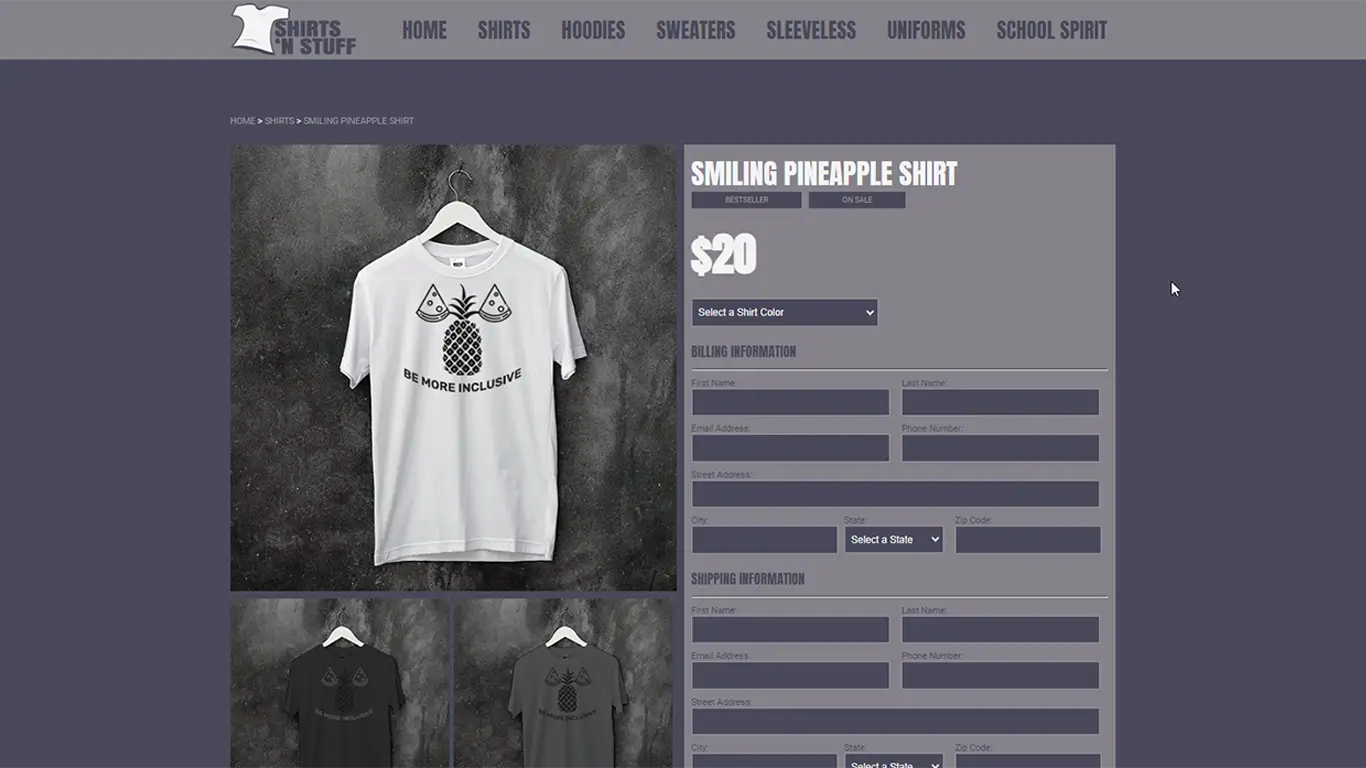
Shirts N' Stuff Checkout Page: A Comprehensive JavaScript Project for Dynamic User Experience
During my college years, one of the standout projects that deeply enriched my understanding of JavaScript was the development of the checkout page for Shirts N' Stuff. This endeavor not only solidified my grasp of core JavaScript concepts but also challenged me to creatively employ a variety of techniques to capture and display user-submitted information dynamically, thus significantly enhancing the overall user experience.
Project Context and Objective
The Shirts N' Stuff checkout page was designed as a final semester project aimed at demonstrating proficiency in JavaScript programming, specifically focusing on the handling and manipulation of form data using HTTP methods.
The primary objective was to utilize the GET method to capture all the information entered by users in a checkout form, then dynamically display that information on a summary page. This flow ensured that users could verify their input before completing their purchase, improving transparency and confidence during the transaction process.
Core Technical Requirements and Challenges
This project stood out because it required the implementation of seven distinct JavaScript codes and functions, each serving a particular purpose to fulfill project criteria. Meeting these requirements demanded not only a firm understanding of syntax and logic but also creativity in combining multiple functions into a cohesive user interface.
Key JavaScript Concepts Employed:
-
Event Handling: Capturing form submission events to prevent default behavior and manage custom processing.
-
GET Method Usage: Encoding user input within the URL query string for transmission and retrieval.
-
DOM Manipulation: Dynamically updating page content to reflect submitted data without page reloads.
-
Form Validation: Ensuring user inputs met predefined criteria before submission.
-
Data Parsing: Extracting and interpreting query string parameters for display purposes.
-
Functions and Scope: Writing reusable functions to modularize code and maintain clarity.
-
Conditional Logic: Implementing decision-making structures to handle various input scenarios.
Each of these elements was thoughtfully integrated to craft a seamless and interactive checkout experience.
Implementation Details: Step-by-Step Breakdown
Form Construction and Submission Handling
The project began with designing a well-structured HTML checkout form, incorporating fields such as:
-
Customer name and contact details.
-
Shipping address.
-
Product selection including quantity and size.
-
Payment options.
Upon form submission, JavaScript intercepted the event using event listeners, preventing the default submission to allow for customized processing.
Encoding User Data Using the GET Method
User inputs were serialized into a query string appended to the URL, enabling the next page to access all data via the URL parameters. This choice required careful encoding of special characters to preserve data integrity during transmission.
Retrieving and Parsing Query Parameters
On the confirmation page, JavaScript functions were employed to:
-
Parse the URL to extract each parameter.
-
Decode the encoded values.
-
Dynamically populate HTML elements with the retrieved information.
This live data binding provided a real-time display of the user's entered information, improving transparency.
Dynamic DOM Manipulation for Enhanced UX
By manipulating the Document Object Model (DOM), the page updated content without requiring a full page reload. Elements such as text fields, summaries, and confirmation messages reflected the current data, creating a fluid and engaging user experience.
Form Validation and Error Handling
Prior to encoding, the form inputs underwent validation checks to ensure:
-
Mandatory fields were completed.
-
Inputs followed formatting rules (e.g., email syntax, phone number length).
-
Quantities were within acceptable ranges.
Any errors triggered dynamic feedback messages, guiding users to correct mistakes before proceeding.
Modularity Through Functions
Each major task was encapsulated within discrete JavaScript functions to promote code organization, maintainability, and reusability. This approach demonstrated my understanding of function scope, parameters, and return values.
Learning Outcomes and Technical Growth
Strengthening Core JavaScript Skills
This project served as a comprehensive review and application of essential JavaScript fundamentals, cementing concepts that form the backbone of interactive web development. My ability to manipulate forms, handle events, and dynamically update content was significantly enhanced.
Problem-Solving in a Real-World Context
Balancing seven distinct JavaScript requirements within a single project challenged me to think creatively and logically. Debugging complex interactions between form submission, data encoding, and DOM updates refined my analytical skills.
User-Centered Design and UX Awareness
By focusing on user experience, particularly in presenting clear and immediate feedback through dynamic content, I gained valuable insight into how frontend behavior impacts overall satisfaction and trust.
Broader Impact and Future Applications
The Shirts N' Stuff checkout page project was more than an academic exercise—it was a practical demonstration of how JavaScript can power real-world e-commerce functionalities. This foundation prepares me to handle advanced tasks such as:
-
Integrating APIs for payment processing.
-
Managing asynchronous requests using AJAX or Fetch.
-
Enhancing accessibility for all users.
-
Implementing state management in complex web applications.
Conclusion
The development of the Shirts N' Stuff checkout page represents a milestone in my programming education, combining technical rigor with creative problem-solving. Through the effective use of JavaScript event handling, form validation, GET method utilization, and DOM manipulation, I crafted an interactive and user-friendly checkout process that meets high standards of modern web design.
This project not only showcased my mastery of JavaScript but also laid the groundwork for more advanced web development projects, underscoring the importance of clean, modular code and thoughtful user interface design.